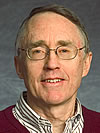 David Pollard |
2016 Structural Geology & Tectonics Career Contribution Award
Presented to David Pollard
Citation by Stephen J. Martel
On behalf of co-nominators Phil Resor and Ashley Griffith, and all the geologists influenced by his extraordinary scientific insights, it is a humbling privilege to introduce David Pollard as the 2016 awardee for the Career Contribution Award from the Geological Society of America Structural Geology and Tectonics Division. Simply put, Dave’s numerous career contributions have greatly elevated the profession.
In his research, Dave has consistently advanced the rigorous, quantitative application of mechanical principles to structural geology, and the value of uniting mechanical principles with careful field observations. He has addressed a broad array of structural processes, including rock fracture, igneous intrusion, shear zone formation, deformation band formation, folding, and fluid flow in fracture systems. His publications, according to Google Scholar, have been cited ~15,000 times; many are seminal treatments.
Dave has served as a leader in the structural geology community. For example, he chaired the preparation of the 2003 National Science Foundation Tectonics Program white paper “New Departures in Structural Geology and Tectonics.” He is a longstanding member of the editorial advisory board of the Journal of Structural Geology.
Dave also has helped pave a road to the future through his teaching and advising. The Rock Fracture Project at Stanford, operated by Dave and Atilla Aydin, and assisted by Dave’s wife Virginia, has been a fertile home for three decades for many graduate students and post-doctoral scholars. Dave has served unselfishly as a superb and inspirational teacher for hundreds of students. He is a wonderful advisor. Dave not only sets a high technical standard for his students, but he consistently demonstrates how to treat others fairly and with respect. Dave is revered by his students.
David Pollard has changed how geologists think about the Earth, and how we are able to examine the Earth. Dave certainly merits the Career Contribution Award.
 2016 Structural Geology & Tectonics Career Contribution Award — Response by David Pollard
2016 Structural Geology & Tectonics Career Contribution Award — Response by David Pollard
Thank you, Steve, for your very generous citation. Thanks also to the officers of the Division, for their dedicated work on behalf of all of us in Structural Geology and Tectonics.
“Career Contribution” sounds a bit ominous, as though my career might be coming to a close. In fact I recently gave up my billet at Stanford, so the department can hire a young structural geologist. Upon retirement I reported to the department chair that I had a dozen papers in preparation with former students, and that Steve and I are working on a textbook for undergraduate students, so I will not be idle in my emeritus status.
I would like to reflect briefly on events that were turning points, and on people who were particularly influential, over the past 50 years. My first structural geology course was like hearing an historical novel spoken with a lilting Scottish brogue by Donald McIntyre of Pomona College. That marvelous introduction to structural geology as natural history was followed by the nuts and bolts of physical processes in geology with Arvid Johnson at Stanford, and an immersion in the work of Grove Karl Gilbert, who provided the inspiration and methodology for my Ph.D. thesis on laccoliths of the Henry Mountains. I also had the privilege to learn about structural geology as a physical science from the papers and lectures of M. King Hubbert. Then, Virginia and I took off for London where I obtained a Diploma of Imperial College, under the inspirational tutelage of Neville Price and John Ramsay.
After four years at the University of Rochester and a very productive decade at the U.S. Geological Survey in Menlo Park, we were back at Stanford where, over the next 30 years, I had the pleasure of mentoring 35 Ph.D. students who are, in large measure, the reason I am receiving this award today. They provided the backbone for our research group. I cannot mention each by name, but let me thank them collectively for their friendship, inspiration, and for a job well done.
The arc of our professional methodology, from natural history to physical science endures. In the paraphrased words of Steven J. Gould, we accept a methodological uniformitarianism that physical laws are constant in space and time as a procedural assumption that is basic to historical inquiry. Thus, we believe that Newton’s laws of motion are valid for all faults and all folds, today and a hundred million years ago.
Natural history, in absence of physical modeling, does not admit a verifiable description of rock deformation. Physical modeling, in the absence of a documented sequence of events from field observations, does not produce reliable geologic history. As a former president of the GSA, E’en Zen, said, the two approaches are as the woof and warp in weaving: neither can serve along.
The contributions upon which this award is based reflect this duality of approaches to structural geology, which my students and I have used over the past five decades.
